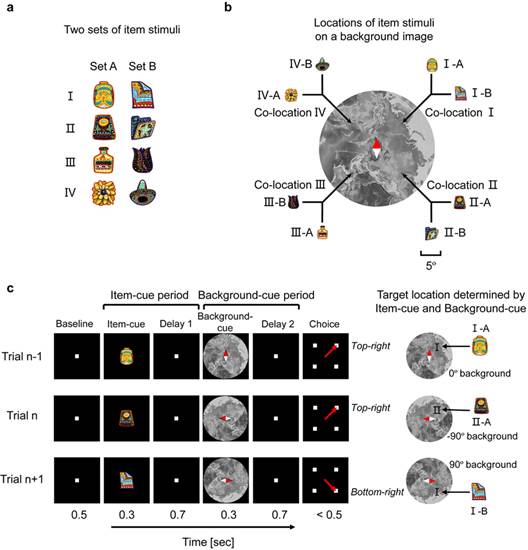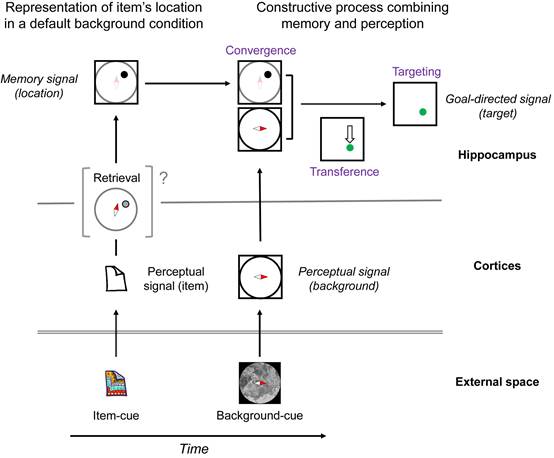On November 18, 2020, a paper entitled “Hippocampal cells integrate past memory and present perception for the future” was published in PLOS Biology by Dr. Yuji Naya’s Lab in the School of Psychological and Cognitive Sciences at Peking University and the PKU-IDG/McGovern Institute for Brain Research. Using a novel memory task for macaque monkeys and single-unit recording technique, the present study revealed the important role of the hippocampus in the process of memory usage.
The ability to use stored information in a highly flexible manner is a defining feature of the declarative memory system. However, the neuronal mechanisms underlying this flexibility are poorly understood. To address this question, we recorded single-unit activity from the hippocampus of 2 nonhuman primates performing a newly devised task requiring the monkeys to retrieve long-term item-location association memory and then use it flexibly in different circumstances (Fig. 1). We found that hippocampal neurons signaled both mnemonic information representing the retrieved location and perceptual information representing the external circumstance. The 2 signals were combined at a single-neuron level to construct goal-directed information by 3 sequentially occurring neuronal operations (e.g., convergence, transference, and targeting) in the hippocampus. Thus, flexible use of knowledge may be supported by the hippocampal constructive process linking memory and perception, which may fit the mnemonic information into the current situation to present manageable information for a subsequent action (Fig. 2).

Fig 1. Constructive memory-perception task. (a) Item stimuli. (b) Item-location association pattern. Two items, one from set A (e.g., I-A) and the other from set B (e.g., I-B), were assigned to each location (e.g., co-location I) on the background image. Scale bar for both item-cue and background-cue stimuli, 5° visual angle. (c) Schematic diagram of the CMP task. An item cue and background cue were chosen pseudorandomly in each trial. The monkeys should maintain fixation on the center until the end of the background-cue period including Delay 2, then saccade to the target location (red arrow) during the choice period. Monkeys were trained using every 0.1° step in orientation from −90° to 90°, though only 5 orientations (−90°, −45°, 0°, 45°, and 90°) were tested during the data acquisition. Relative sizes of the item-cue stimuli to the background-cue stimuli were magnified for display purpose. CMP, constructive memory-perception.

Fig 2. Constructive process for the flexible use of memory. Schematic diagram of neuronal signals during a trial of the CMP task, in which the item cue and the orientation of background cue were I-B and 90°, respectively. In the HPC, the retrieved location of the item is represented relative to the 0° background image, which may correspond to the top right in egocentric space. The incoming perceptual signal is integrated with the memory signal to construct an updated information signaling the target location by following sequential neuronal operations: convergence (i.e., memory [co-location I on the 0° background] + perception [90° background]), transference (i.e., from the top right [co-location I on the 0° background] into the bottom right [co-location I on the 90° background]), and targeting (i.e., coding bottom right). It is still unknown which brain area is involved first in the retrieval of item-location association memory and whether the retrieved memory content is same as the memory signal in the HPC. CMP, constructive memory-perception; HPC, hippocampus. Hippocampus fit the past memory into the current situation for future action
Cen Yang, a Ph.D. student (graduated) from the Center for Life Sciences is the first author. Dr. Yuji Naya from the School of Psychological and Cognitive Sciences and McGovern Institute of Brain Science at Peking University is the corresponding author. This study was funded by the National Natural Science Foundation of China and the Center for Life Sciences.
Yang C, Naya Y (2020). Hippocampal cells integrate past memory and present perception for the future. PLoS Biol, 18(11): e3000876. (https://doi.org/10.1371/journal.pbio.3000876)


